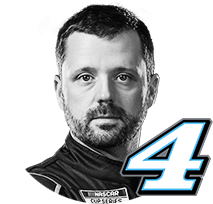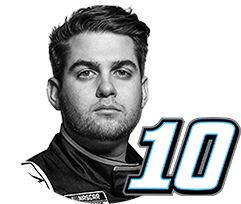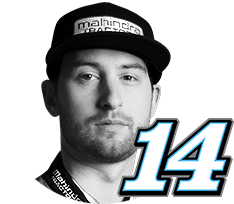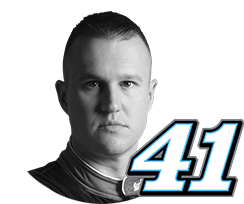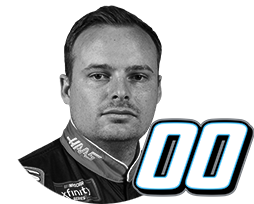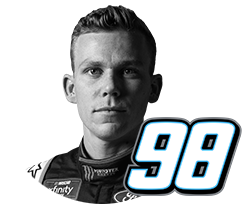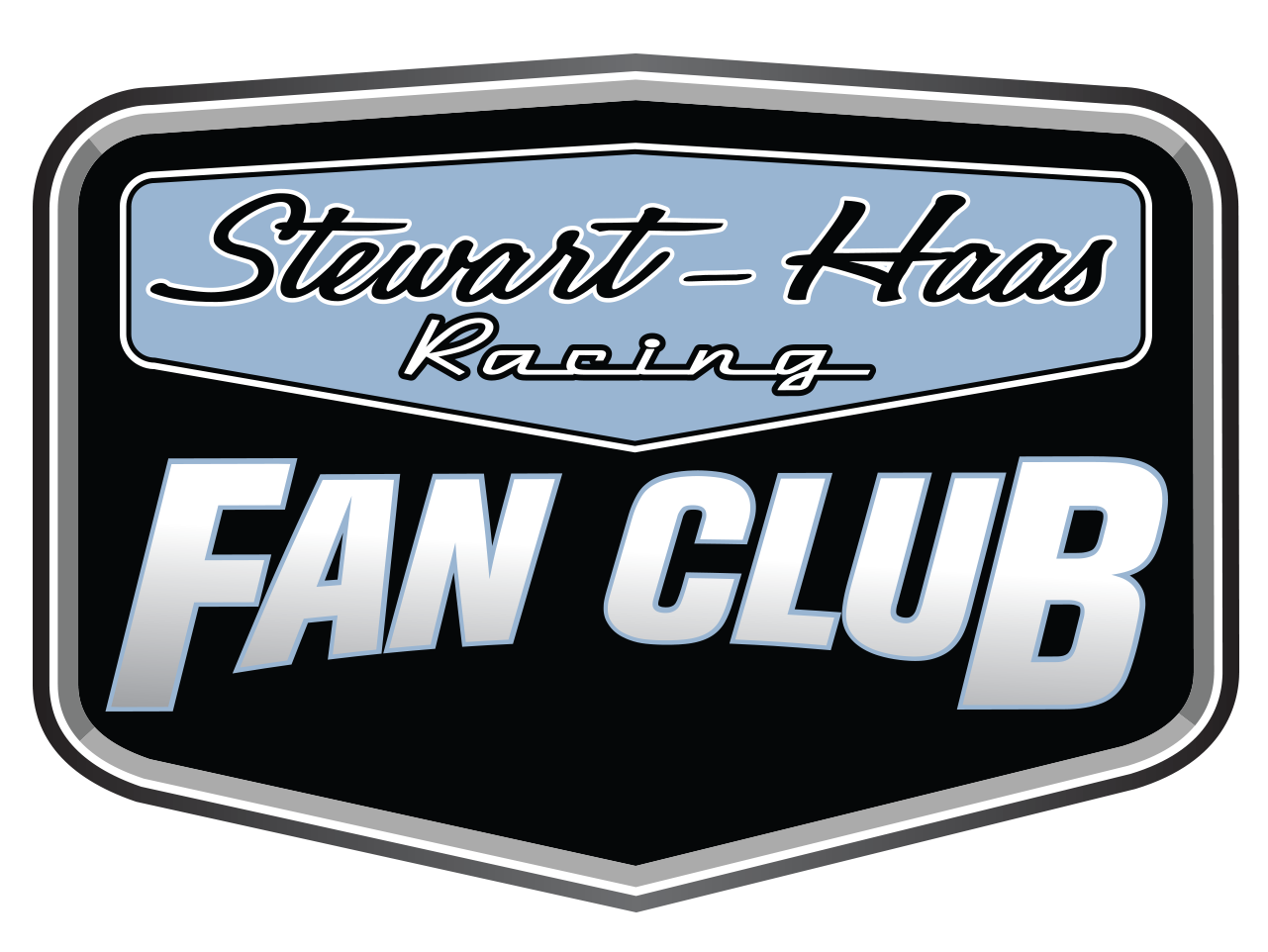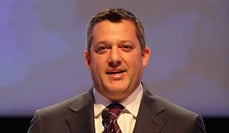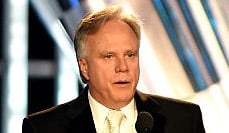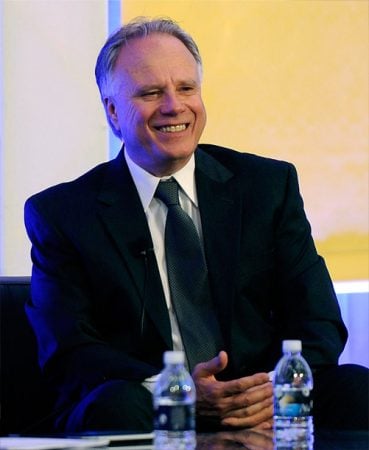
Birthdate: November 12, 1952
Birthplace: Youngstown, Ohio
Hometown: Los Angeles
Residence: Henderson, Nevada
Career Overview
INDUSTRIALIST:
Find a challenge. Create a good, efficient and cost-effective solution. Repeat.
For Gene Haas, co-owner of Stewart-Haas Racing (SHR) with three-time NASCAR Cup Series champion Tony Stewart, that has proven to be his formula for success in business, racing and philanthropy.
Haas was born on Nov. 12, 1952 in the industrial town of Youngstown, Ohio. For someone born in what used to be known as the “Industrial Heartland of North America,” it is appropriate that Haas has become a captain of industry, where his company, Haas Automation, is the largest CNC machine tool builder in North America.
Haas’ family moved to Los Angeles when he was still a child, where his father worked as a designer of electrical cabinets for Hughes Aircraft and his mother was a schoolteacher. The second oldest of four children, Haas’ family instilled at an early age the importance of hard work and responsibility. He delivered newspapers while in elementary school and at age 14 began working in a machine shop where he swept floors and kept the facility clean. After only six months, Haas was setting up lathes and conventional milling machines. He continued to work at machine shops throughout high school and college, mastering the machining techniques that would lead him to found Haas Automation in 1983.
Haas graduated from high school in Mission Hills, California, in 1970. After high school, he attended California State University-Northridge where he studied engineering and business. He graduated in 1975 with a Bachelor of Science degree in accounting and finance.
In 1978, after working for three years as an industrial programmer, Haas founded Proturn Engineering, a small contract machine shop in Sun Valley, California. Haas worked side-by-side with his two employees at Proturn Engineering, machining parts for the electronics and aerospace industries. It was during that time Haas developed a fully-programmable 5C collet indexer to boost productivity in his own shop. The Haas 5C was the industry’s first device to automatically re-position parts accurately for machining by simply pressing a button, as opposed to having to reposition the material by hand – a cumbersome and time-consuming process.
The machine-tool industry received the economical and reliable Haas 5C Indexer with enthusiasm, and in 1983 Haas Automation, Inc., was born. The company started with three employees in a 5,000-square-foot facility. During the next four years, Haas expanded his product line to include a wide selection of fully-programmable rotary tables, indexers and machine-tool accessories. Haas Automation quickly became the leader in fourth- and fifth-axis parts positioning.
In 1987, Haas took what he learned from the 5C Indexer and designed and developed his first vertical machining center (VMC) – the VF-1. The prototype was introduced to the manufacturing world in 1988 at the International Machine Tool Show (IMTS) in Chicago. Haas listed the machine at the unheard price of $49,900. Industry experts were skeptical that an American company could manufacture and sell a machine tool for less than $50,000.
Haas Automation silenced the skeptics. The new product was a success. Today, virtually every manufacturer of vertical machining centers worldwide produces a similar machine in the $50,000 price range.
Over the next five years, Haas Automation began to grow. In 1992, Haas Automation moved to a larger facility in Chatsworth, California, to keep up with demand. In 1997, again seeking to keep up with the success of its growing product line and production demands, Haas Automation moved once more, to its current location in Oxnard, California, where all of its products are manufactured.
The 1-million-square-foot facility in Oxnard is one of the largest, most modern machine tool manufacturing operations in the United States. Haas Automation currently produces four major product lines: vertical machine centers (VMCs), horizontal machine centers (HMCs), computer numeric control (CNC) lathes and rotary tables.
Haas products are sold through a worldwide network of more than 152 Haas Factory Outlets in more than 87 countries administering the industry’s best support and service. And HaasTooling.com provides an easy and direct channel to buy the same high-quality cutting tools used in Haas’ own state-of-the-art machine shop.
Although he founded Haas Automation and serves as its president, Haas’ primary role has always been heading up the engineering department. Ninety-five percent of all new design ideas originate through Haas himself. He sketches out his ideas and then turns them over to his engineers for refinement. After reviewing the engineers’ work, Haas makes further modifications, as required. One of Haas Automation’s strengths is its ability to take a new machine from initial concept, through design, and into production in just six to 12 months.
Haas’ desire to push innovation and tackle new challenges goes beyond his interest in machine tools.
In 2007, Haas built Windshear, one of the most advanced automotive wind tunnels in the world. It opened to its first customer, a Formula One team, in September 2008.
The facility’s centerpiece is a rolling road, which allows a full-size car to be restrained in place directly on top of a massive, treadmill-like stainless steel belt rotating at speeds up to 180 mph. The rolling road accurately simulates the dynamics of a car on the racetrack, unlike traditional fixed-floor tunnels. The high-tech rolling road is able to accelerate from zero to 180 mph in less than one minute, with temperatures controlled within 1-degree Fahrenheit.
Windshear was the first wind tunnel of its kind in North America and only the third rolling-road wind tunnel of its scale in existence. Windshear is available for hire to all motorsports teams and auto manufacturers. NASCAR, INDYCAR, IMSA and NHRA teams utilize Windshear, as does the United States Council for Automotive Research (USCAR), which has conducted tests on production cars at Windshear.
TEAM OWNER:
In addition to his professional accomplishments, Haas is passionate about motorsports. In the same hands-on manner that he pursues his entrepreneurial and philanthropic endeavors, Haas pursues racing. He has competed successfully in off-road racing and sponsored numerous race teams through the years in NASCAR, INDYCAR and Formula One.
Haas started as a Formula 5000 mechanic in 1971 while he was still in high school, with his first race being the Long Beach Grand Prix.
“I was with Wrangler Racing and I went on that tour for a bunch of years. The whole experience was actually from high school to about 1975,” Haas said. “I used to work with Red LeGrand who had an operation near Hollywood building the D Sports Racing cars and Formula Fords. I was just sitting there making stuff, welding things together, and those were the days you could do a Formula 5000 part for $2,000.”
Haas traveled all over the United States.
“That was a fun time, but after ’75 I started with manufacturing and machine tools. Then I really didn’t get involved (in racing) again until 1995 with Rick Hendrick where we sponsored the 24 car in NASCAR with Jeff Gordon.”
That associate sponsorship with Hendrick Motorsports soon morphed into a much more involved racing endeavor.
In 2002, Haas formed his own NASCAR Cup Series team, Haas CNC Racing. Originally headquartered in Concord, North Carolina, Haas CNC Racing began as a single-car team with chassis and technical support from Hendrick Motorsports. The team made its debut on Sept. 29, 2002 at Kansas Speedway in Kansas City with driver Jack Sprague.
The team raced only two more times in 2002, but by 2003, Haas CNC Racing was running the full NASCAR Cup Series schedule.
In 2006, Haas CNC Racing relocated to a new, state-of-the-art, 140,000-square-foot facility in Kannapolis, North Carolina, where it began fielding two, full-time NASCAR Cup Series teams.
On July 10, 2008, Haas announced that he had partnered with Stewart, then a two-time NASCAR Cup Series champion. The new operation, known as Stewart-Haas Racing, became official in January 2009. The team fielded two NASCAR Cup Series entries – one for Stewart and another for Ryan Newman.
Haas immediately began to see the results of his new partnership. Stewart finished eighth in the season-opening Daytona 500 at Daytona (Fla.) International Speedway to score the first top-10 for SHR in just its first points-paying race. In late March, Stewart and Newman placed both cars among the top-10 in a race for the first time when Stewart finished third and Newman finished sixth at Martinsville (Va.) Speedway. In early May, SHR placed both cars among the top-five in a race for the first time when Stewart finished second and Newman finished fourth at Richmond (Va.) Raceway.
Then on May 16, Stewart scored the first NASCAR Cup Series victory for SHR in the non-points All-Star Race at Charlotte (N.C.) Motor Speedway. The following week, on May 21, Newman scored the first NASCAR Cup Series pole for SHR in the Coca-Cola 600 at Charlotte.
SHR recorded its first points-paying NASCAR Cup Series victory when Stewart won the Pocono 500 at Pocono (Pa.) Raceway by 2.004 seconds over runner-up Carl Edwards. It marked the first time a driver/owner won a points-paying NASCAR Cup Series race since Ricky Rudd on Sept. 27, 1998 at Martinsville.
Stewart would go on to score SHR’s second NASCAR Cup Series win at Daytona in July and its third at Watkins Glen (N.Y.) International in August.
By Sept. 12, following the conclusion of the NASCAR Cup Series race at Richmond – the cutoff race for the NASCAR Playoffs – SHR was the only organization to place all of its teams in the playoffs.
With its inaugural season complete, SHR had placed both of its cars among the top-10 in the season-ending point standings. Stewart finished sixth in points and Newman finished ninth.
In 2010, SHR recorded three NASCAR Cup Series wins. Newman reached victory lane first when he won in April at Phoenix Raceway. Stewart won twice – first in September at Atlanta Motor Speedway and again in October at Auto Club Speedway in Fontana, California. Stewart would go on to qualify for the playoffs and finish the season seventh in points. Newman finished 15th.
In August 2011, SHR announced it was adding a third team for INDYCAR star Danica Patrick, who would join the team for a limited NASCAR Cup Series schedule in 2012.
In September 2011, Stewart and Newman qualified for the playoffs. Stewart won five of the final 10 races, including the season finale at Homestead-Miami Speedway. With the victory, Stewart ended the season in a numerical tie with Carl Edwards, as each driver had 2,403 points. But Stewart won the championship by virtue of a tiebreaker, as his five wins on the season trumped Edwards’ lone victory. It was the closest NASCAR Cup Series championship in history. While it was Stewart’s third NASCAR Cup Series title, it was the first for SHR.
SHR picked up in 2012 just as it left off in 2011, as Stewart scored wins at Las Vegas Motor Speedway and Fontana. Newman also picked up a win early in the season at Martinsville. Stewart went on to win at Daytona in July and at Atlanta in August. In total, Stewart, Newman and NASCAR newcomer Patrick combined to collect five NASCAR Cup Series wins, 18 top-fives and 30 top-10s, along with a pole. Stewart qualified for the playoffs and finished ninth in points.
Patrick made the jump to a full-time NASCAR Cup Series schedule in 2013, joining SHR teammates Stewart and Newman, and she did it in a big way by winning the pole for the Daytona 500. Patrick’s pole win was the first NASCAR Cup Series pole ever won by a woman. Stewart would score the first win of the season for SHR at Dover (Del.) International Speedway in June and Newman would follow by winning the Brickyard 400 at Indianapolis Motor Speedway in July. Newman left the team at season’s end for another opportunity.
In 2014, SHR grew again with the addition of a fourth car for Kurt Busch, sponsored by Haas Automation. Also joining SHR was Kevin Harvick. The duo combined to win six races in 2014, with both drivers qualifying for the playoffs. Busch won at Martinsville in April while Harvick took victories at Phoenix in March, Darlington (S.C.) Raceway in April and Charlotte in October before scoring back-to-back wins in November at Phoenix and Homestead to secure the 2014 NASCAR Cup Series championship. It was the second NASCAR Cup Series title for SHR and it came only two years after Stewart won the team’s first championship.
SHR recorded five wins in 2015. Harvick took three victories – Las Vegas in March, Phoenix in March and Dover in October. Busch won at Richmond in April and at Michigan International Speedway in Brooklyn in June. Both drivers qualified for the playoffs, with Harvick finishing second in the championship by a single point.
Three of SHR’s four drivers made the playoffs in 2016 as Harvick, Busch and Stewart all scored victories. Harvick won four races – Phoenix in March, Bristol (Tenn.) Motor Speedway in August, New Hampshire Motor Speedway in Loudon in September and Kansas Speedway in October – while Busch won at Pocono in early June and Stewart won at Sonoma (Calif.) Raceway in late June, scoring his 49th and final NASCAR Cup Series victory before retiring as a NASCAR driver at the conclusion of the season. It was another successful year, but SHR opted not to rest on its laurels. It announced that it would switch manufacturers to Ford beginning with the 2017 season.
Its inaugural year with Ford started off with a bang as Busch won the season-opening Daytona 500. Harvick also joined Busch in the winner’s circle, taking victories at Sonoma in June and Texas Motor Speedway in Fort Worth in November. Both drivers represented SHR in the playoffs, with Harvick advancing all the way to the Championship 4.
The 2018 season was SHR’s strongest yet, and it came as the organization celebrated its milestone 10th anniversary. Twelve points-paying victories were scored in the NASCAR Cup Series – the most of any team – and each driver in the SHR stable contributed. Harvick led the way with eight wins, Clint Bowyer had two victories, and Busch and Aric Almirola had a win apiece. As result, SHR was the only four-car team to place all of its drivers in the NASCAR Playoffs. Each advanced to the penultimate Round of 8, with Harvick making it to the Championship 4.
In addition to his eight NASCAR Cup Series wins, Harvick also won the All-Star Race at Charlotte. It was the 50th overall victory for SHR, and it came in the same event where SHR scored its first win nine years prior.
SHR’s stranglehold on the competition in 2018 was best exemplified by its performance during the 31st event of the year at Talladega (Ala.) Superspeedway. SHR drivers qualified 1-2-3-4 for the first time in team history, led by Busch’s pole-winning speed of 195.804 mph. And with Bowyer, Harvick and Almirola qualifying right behind him, it marked the first time in NASCAR history where a four-car organization qualified 1-2-3-4. This dominance continued into the race, as SHR drivers led 155 of the race’s 193 laps (80.3 percent) with Almirola taking the victory by .105 of a second over Bowyer.
The team’s success in the NASCAR Cup Series extended to its NASCAR Xfinity Series operation. The second-year squad earned three wins – one each by Harvick, Chase Briscoe and Cole Custer – and scored the Xfinity Series owners’ championship.
SHR’s winning ways have continued into its second decade.
Four NASCAR Cup Series wins and eight Xfinity Series victories were earned in 2019, and Harvick represented SHR in the Championship 4 for the fifth time in the last six years while Custer finished runner-up in the Xfinity Series championship for a second straight season.
The momentum continued in 2020 with 10 NASCAR Cup Series victories and nine Xfinity Series wins.
Almirola kept the winning streak alive in 2021 with a victory in July at New Hampshire, while Harvick and Briscoe added to SHR’s win tally in 2022. Briscoe took the checkered flag in just his 40th career NASCAR Cup Series start in March at Phoenix, and the victory secured Briscoe’s place in the NASCAR Playoffs while earning him the honor of being the 200th Cup Series winner in NASCAR history. Harvick, meanwhile, won back-to-back races in August at Michigan and at Richmond (Va.) Raceway, with the Richmond triumph being Harvick’s milestone 60th career NASCAR Cup Series win.
In 2023, SHR endured a rare winless season in the NASCAR Cup Series, but its NASCAR Xfinity Series teams offset that loss, winning the championship on the strength of a three-win campaign by Custer. Riley Herbst augmented Custer’s accolades, joining him in the playoffs and scoring a maiden victory in October at Las Vegas.
NASCAR isn’t the only growth area for Haas’ motorsports ambitions. On April 11, 2014, Haas was granted a license by the Federation Internationale de l’Automobile (FIA) to join the starting grid of the FIA Formula One World Championship in 2016. In its inaugural season, Haas F1 Team finished eighth in the constructors’ standings with a total of 29 points, the most of any new team in this millennium. The outfit followed up that run with an even stronger sophomore campaign, earning 47 points and maintaining its eighth-place standing. Its 2018 season remains its best so far, with Haas F1 Team finishing an impressive fifth in the constructors’ standings with 93 points.
The first American Formula One team since 1986 operates out of a 125,000-square foot facility adjacent to Haas’ NASCAR Cup Series team in Kannapolis, North Carolina. Haas F1 Team also has a European base in Banbury, Oxfordshire, U.K., allowing for easier and quicker access to the team’s overseas suppliers and streamlined logistics for travel to European races.
PHILANTHROPIST:
Haas established the non-profit Gene Haas Foundation in 1999 to help fund community humanitarian causes as an official commitment to corporate and social responsibility. The Foundation supports local, state and international communities through grants to charities, non-profit organizations and other philanthropic foundations. Since its inception, the Gene Haas Foundation has awarded nearly $25 million to almost 1,000 organizations such as the YMCA, United Way, Salvation Army, Boys and Girls Clubs of America, Food Share, National Breast Cancer Foundation, American Red Cross and many others.
Haas is also a firm believer in education. The Gene Haas Foundation supports a variety of programs, particularly in the technical and engineering fields at schools, colleges and universities worldwide, including Ranken Technical College, Rensselaer Polytechnic Institute, and his alma mater, California State University-Northridge. Additionally, the Gene Haas Foundation has provided grants and scholarships for the American Association of University Women, the NAACP, the Society of Manufacturing Engineers Education Foundation and numerous others.
To augment the Foundation’s work, Haas and Haas Automation worked with high schools, community colleges and universities across the country and around the world to build its Haas Technical Education Community (HTEC), a support system for manufacturing training. HTEC centers provide an environment that allows students to take theory out of the classroom and apply it within modern manufacturing using Haas-brand CNC machine tools and other modern equipment. Students learn machining and metalworking skills through a hands-on approach, using the same Haas CNC machine tools they will encounter upon entering the workforce.

